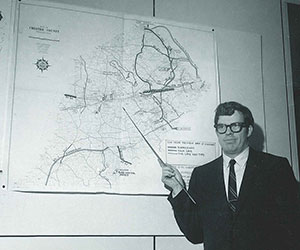CCPC's 75th — CCPC's First Director, 1962

When the Chester County Planning Commission (CCPC) was established by the County Commissioners back in 1950, it operated with limited resources and no dedicated staff — subdivision plans were reviewed by appointed members and the County Engineer. But in the summer of 1962, the county took a major step forward by hiring CCPC's first permanent staff — a small team of technical and clerical professionals from the private consulting firm, Harkins and Alvare, along with several part-time employees.
Among this group, one individual was professionally trained as a planner: Richard P. Byler. In October of 1962, Mr. Byler became CCPC's first full-time staff member, serving as both County Planner and Director.
At the time of Mr. Byler's hiring, planning was relatively new concept in Chester County and the public was — as Mr. Byler described in a 2003 interview with former CCPC Demographer, Bob Bielski — "very, very cautious." Because of this, Mr. Byler spent much of his time focusing on data and mapping. "I do always believe that good data and mapping can minimize a lot of controversy such as soil and flood plain maps, so we did a lot of data and mapping," he said. He also mentioned the first report he published — a detailed analysis of the 1960 census — in which he developed a whole map chart that had to be typed on the typewriter and then pasted on the maps.
CCPC's early staff had expertise in areas besides planning (draftsmen, geographers, artists), so Mr. Byler took on most of the planning aspect himself. "It wasn't until the 1970s that we had staff knowledgeable in planning," he said.
Under Mr. Byler's leadership, CCPC initiated various educational programs to help the public have a greater understanding of the planning process. He started a series of planning classes at Henderson High School and other parts of the county. He also organized and led seminars, workshops, and conferences that were not only well attended, but instrumental in guiding local planning commissions to develop municipal plans and land use control ordinances.
Mr. Byler noted that his greatest technical achievement in Chester County was the release of the Chester County Natural Environment and Planning in 1963. Other accomplishments during his time included the first planning report titled The Road Ahead in 1964; the Act 537 sewage plan, which Mr. Byler described as "greatly significant"; and the development of the Struble Trail, which Mr. Byler remembered as "the first rail to trail in Southeast PA."
Throughout his 13 years as Director, Mr. Byler advocated for the hiring of additional staff, and cultivated key partnerships with organizations such as the County Superintendent of Schools, the Chester County Postmasters' Association, and the Pennsylvania State Climatologist.
The 1960s was a transformative time, as it also marked the formation of the Delaware Valley Regional Planning Commission and SEPTA, in which Chester County was very much involved at the policy level.
In the early 1960s, Mr. Byler recalled only about 20 of Chester County's 72 (at the time) municipalities having planning and zoning, but by the end of the 1960s, there was an immense change as almost all municipalities had local planning policies and regulations to some extent. "In a decade, that was an amazing turnaround," he said.
In January 1975, Mr. Byler was succeeded by Norton Kent as County Planner, followed by George W. Fasic in April 1976, but his impact continued to be felt for decades. Mr. Byler's legacy still carries on today through his leadership and commitment to building a thoughtful, data-driven foundation for planning in Chester County.


